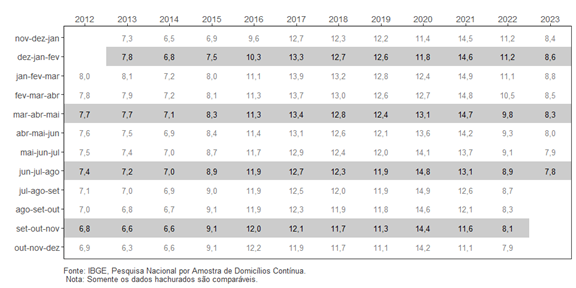Continuous PNAD: unemployment rate is 7.8% and underutilizationn rate hits 17.7% in quarter ended August
September 29, 2023 09h00 AM | Last Updated: September 30, 2023 12h04 AM
The unemployment rate (7.8%) of the quarterended August 2023 dropped 0.5 percentage points (p.p.) from the quarter MArch-May (8.3%) and dropped 1.1 p.p. against the same period in 2022 (8.9%). This is the lowest unemployment rate since the moving quarter ended February 2015 (7.5%).
| Indicator/Period | Jun-Jul-Aug 2023 | Mar-Apr-May 2023 | Jun-Jul-Aug 2022 |
|---|---|---|---|
| Unemployment rate | 7.8% | 8.3% | 8.9% |
| Underutilization rate | 17.7% | 18.2% | 20.5% |
| Usual real earnings | R$ 2,947 | R$ 2,914 | R$ 2,818 |
| Change of usual real earnings in relation to: | Stable | 4.6% | |
Theunemployed population (8.4 million persons) dropped by 5.9% (528 thousand persons) in the quarter and by 13.2% (1.3 million persons) in the year. That is the lowest figure since the quarter ended June 2015 (8.5 million).
The employed population (99.7 million persons) grew by 1.3% (1.3 million more persons) in the quarter and by 0.6% (641 thousand more persons) in the year. The employment-population ratio (percentage of employed persons in the population at working age) was estimated at 57.0%, having risen by 0.6 p.p against the quarter March-MayMarch-May (56.4%), being stable in the year.
The compound underutilization rate (17.7%) fell by 0.5 p.p. in the quarter (18.4%) and dropped by 2.9 p.p. from the quarter ended July 2022 (20.5%). That was the lowest rate since the quarter ended December 2015 (17.4%). Theunderutilized population (20.2 million persons) feel by 2.2% in the previous quarter and retreated 15.5% in the year. That was the lowest number since the quarter ended in February 2016 (19,983 million persons).
The time-related underemployed population (5.3 million persons) increased by 3.9% (or 199 thousand persons) in the quarter and dropped by 17.3% (less 1.7 million persons) in the year.
The population out of the labor force (66.8 million persons) dropped by 0.5% against the previous quarter (347 thousand persons) and increased by 3.4% in the annual comparison (by 2.2 million persons).
The discouraged population (3.6 million persons) stood stable from the previous quarter and dropped by 16.2% (568 thousand persons) in the year. It was the lowest number since the quarter ended September 2016 (3.5 million persons). The percentage of discouraged workers in the workforce or discouraged population (3.2%) dropped by 0.2 p.p. in the quarter and by 0.6 p.p. in the year. That was the lowest rate since the quarter ended August 2016 (3.2%).
The number of workers with a formal contract in the private sector (except domestic workers) reached 37.248 million persons, an increase of 1.1% (422 thousand more persons) in the quarter and of 3.5% (1.3 million persons) over 2021in the year. That was the highest figure since February 2015 (37,288 million persons). The number of workers without a formal contract in the private sector (13.2 million) grew by 2.1% in the quarter (266 thousand persons) and stood stable in the year.
The number of self-employed workers (25.4 million persons) stood ained stable from the previous quarter and dropped by 2.0% in the year (509 thousand persons).
The number of domestic workers (5.9 million persons) grew by 2.8% against the previous quarter and stood stable from the quarter ended August 2022.
The number of employers (4.2 million persons) stood stable in both comparisons, as well as the number of workers in thepublic sector sector (12.2 million persons).
The informality rate was 39.1% of the employed population (or 38.9 million informal workers) against 38.9% in the previous quarter and 39.7% in the same quarter of 2022.
Usual real earnings (R$2,947) stood stable in the quarter and increased by 4.6% in the year.
Theusual real wage bill (R$288.9 billion) hit a record figure in the time series, with an increase of 2.4% from the previous quarter and of 5.5% in the annual comparison.

Estimated at 108.1 million persons in the moving quarter June-August 2023, the workforce (employed and unemployed persons) increased by 0.7% (725 thousand persons) from the quarter March-May and dropped by 0.6% (636 thousand) in the year.
The following groups of activity recorded increases against the previous moving quarter: Information, Communication and Financial, Real Estate, Professional and Administrative Activities (2.3%, or 275 thousand persons), Public administration, defense, social security, education, human health and social services (2.4%, or 422 thousand persons) and Domestic services (2.9%, or 164 thousand persons). The remaining groups did not record significant changes.
From the quarter June-August 2022, the following groups recorded increases: Transportation, storage and mailing (4.4% or 230 thousand persons), Information, communication and financial, real estate, professional and administrative activities (5.1% or 596 thousand persons) and Public administration, defense, social security, education, human health and social services (4.0% or 699 thousand persons). Decreases were registered by: Agriculture, livestock, forestry, fishing and aquaculture (-5.1% or 446 thousand persons) and Construction (-3.5% or 265 thousand persons).

As for average usual real earnings (R$ 2,947), against the previous moving quarter, there was increase only in the category of Industry (2.8%, or R$76). The remaining groups did not record significant changes. The comparison with the quarter June-July-August 2022 indicated an increase in the categories: Industry (3.8%, or R$105); Trade, repair of motor vehicles and motorcycles (4.7%, or R$ 109); Lodging and feeding (14.3%, or R$247); Public administration, defense, social security, education, human health and social services (4.5%, or R$176) and Domestic services (5.3%, or R$58). The remaining groups did not record significant changes.
All the employment type stood stable in terms of earnings in relation to the previous quarter. In the annual comparison, the following categories recorded decreases: Workers a formal contract (3.0% or 0R$79), Workers without a formal contract (6.9% or R$128), Domestic workers (5.3% or more R$58), Workers in the public sector (including statutory workers and the military) (4.2% or more R$180), Self-employed persons (6.8% or more R$149).

